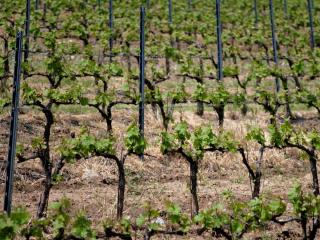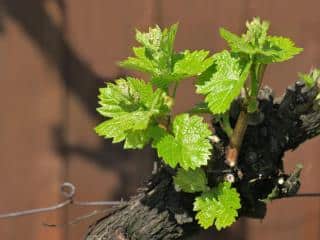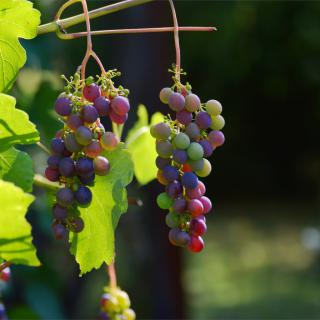Grapevine is a beautiful fruit vine, offering us grapes at the end of summer.
Key Grapevine facts
Name – Vitis vinifera
Family – Vitaceae
Type – fruit shrub
Height – 6 ½ to 16 feet (2 to 5 meters)
Exposure – full sun
Soil: ordinary, chalky – Foliage: deciduous – Harvest: early-mid fall
Care, treatment and planting are all good practices that will let you quickly produce nice harvests from your vine.
Planting grapevine
It is recommended to plant grapevine in fall or in spring. The better of the two options is fall for planting, because it makes root development before winter possible, and growth in spring will be stronger.
 Out of these two seasons, simply avoid freezing or high temperatures for planting.
Out of these two seasons, simply avoid freezing or high temperatures for planting.
If you’re planting in spring or summer, remember to water regularly after planting to ensure rooting in.
- Grapevine requires exposure to the sun or it won’t produce any fruits.
- Grapevine doesn’t cope well with strong winds, nor does it do well in enclosed locations where it might be subject to some fungus like downy mildew.
- Grapevine likes well drained soil and abhors stagnating water.
- Follow our advice on planting shrubs.
Pruning and caring for grapevine
 This is performed from November to mid-April, as long as it isn’t freezing. This is when the grapevine is in a dormant state.
This is performed from November to mid-April, as long as it isn’t freezing. This is when the grapevine is in a dormant state.
Pruning the grapevine is important, because this determines the quality of the grape harvest, helps direct the growth of stems and reduces appearance of diseases.
All there is to know about grapevine
Grapevine is an amazing shrub to grow in your own garden.
Some species are perfectly suited to being eaten directly such as chasselas.
Attached to a lattice along a wall and well-kept, grapevine will soon reward you with the joy of savoring your own grapes, bursting with sweetness.
But treatments are quite extensive and pruning is mandatory to ensure fruit formation and produce a rich and abundant harvest.
Diseases and parasites infecting grapevine
Sadly, grapevine is a rather fragile shrub and a few good practices help avoid diseases.
First, with a regular spraying of Bordeaux mixture. This effective fungicide is part of treating preventively and must be sprayed on the leaves as soon as they appear and up until two weeks before harvesting the grapes.
Main diseases & parasites that infect grapevine and grapes
Species and varieties of grapevine
 The Vitis genus is divided into about 65 species found also in Asia and in North America.
The Vitis genus is divided into about 65 species found also in Asia and in North America.
Their fruits are edible, and some grapevines are cultivated like the Vitus labrusca, which is sometimes known as “raspberry grapes” or “Isabelle”.
Curiously, a French law dating back to 1934 prohibits the growing and selling of this species…
The initial goal was to avoid overproduction. This grapevine tends to grow a lot and can climb up to 100 feet (30 meters). It produces abundant fruits which have a delicate taste.
Among the various common grapevine cultivars you’ll find:
Early harvest (August) white grapes
- ‘Muscat de Saumur’ – round, tasty.
- ‘Madeleine Royale’ – very juicy but vulnerable to Botrytis fungus in case of wet summer or fall.
- ‘Pearl of Csaba’ – sweet, thin-skinned, birds feast on it.
- ‘Perdin’ – 7 oz (200 g) bunches on average, small round berries, golden when ripe. This variety is recommended in exposed and rather colder locations.
September harvest
- ‘Golden Chasselas’ or ‘Fontainebleau Golden Chasselas’ – one of the most loved table grapes. The French village of Thomery in Seine-et-Marne is famous thanks to this variety.
- ‘Forster White Seedling’ – white, sweet, fears the cold.
- ‘Royal Pink Chasselas’ – magnificent bunches but not so tasty.
- ‘Frankenthal’ – huge black grapes.
- ‘Perlette’ – large round and golden grapes, almost seedless, crunchy and musk-scented flesh, very sweet. These grapes can be dried. Vigorous and very productive variety.
Semi-late harvest (October) white grapes
- ‘Napoleon Chasselas’, ‘Blanc de Frontignan Muscat’, ‘Regina’, ‘Italia’ – large bunches, thick-skinned, not so tasty flesh.
- ‘Black Hamburg Muscat’ – thin-skinned grains, a bit elongated, musk-scented flesh. Variety that resists diseases rather well.
Late harvest (November) white grapes
- ‘Muscat of Alexandria’ – very fine, delicate taste.
- ‘Dattier de Beyrouth’ – elongated green-white grains that resemble dates.
- ‘Alphonse Lavallee’ – grown in the South of France. Large round grains with thick skin and crisp flesh, not always juicy.
The best table grape varieties
- ‘Amandin’ – white, harvest around October 15th, crisp musk-scented grains.
- ‘Cardinal’ – black, harvest on September 20th, very large bunches that should be wrapped in support bags, thin skin, grains can burst.
- ‘Golden Chasselas’ – white, harvest around September 15th, hardy variety, easy, juicy, well balanced, melts in the mouth.
- ‘Marseille Early’ – harvest around September 15th, one of the first, warmer climates only. Taste lingers for quite a while. Harvest very ripe.
- ‘Madeleine Royale’ – white, harvest around September 10th, vigorous and fertile, juicy, sweet, not so fragrant, tender, fine flesh.
- ‘Reine Muscat’ – white, harvest around September 5th, abundant productivity, easy growing, large oval grain that is sweet and scented of musk and blackcurrant.
- ‘Perdin’ – white, harvest around September 5th, very resistant to diseases, small sweet grains.
- ‘Pearl of Csaba’ – white, harvest around August 15th, for warmer climates, juicy, golden thin skin.
Smart tip about grapevine
You’ll be eating your own grapes, so protect your health and the environment by choosing organic treatment products, they have become very effective today!
Images: Pixabay: Cornelia Gerhardt, H. Hach, Jill Wellington, shaymen99


 Out of these two seasons, simply avoid freezing or high temperatures for planting.
Out of these two seasons, simply avoid freezing or high temperatures for planting. This is performed from November to mid-April, as long as it isn’t freezing. This is when the grapevine is in a dormant state.
This is performed from November to mid-April, as long as it isn’t freezing. This is when the grapevine is in a dormant state. The Vitis genus is divided into about 65 species found also in Asia and in North America.
The Vitis genus is divided into about 65 species found also in Asia and in North America.